CFD Analysis of the Forced Airflow and Temperature Distribution in the Air-Conditioned Operator’s Cabin of the Stationary Rock Breaker in Underground Mine under Increasing Heat Flux
Abstract
1. Introduction
2. State of the Art
3. Materials and Methods
3.1. Governing Equations
3.2. Turbulence Model Applied and Its Description
3.3. Geometry
3.4. Mesh
3.5. Boundary Conditions Applied and Their Determination
4. Results
5. Conclusions
Author Contributions
Funding
Data Availability Statement
Acknowledgments
Conflicts of Interest
References
- KGHM Polska Miedź, S.A. Deposit Mining Technology. Available online: https://kghm.com/en/our-business/processes/ore-mining/ (accessed on 11 January 2023).
- Krot, P.; Śliwiński, P.; Zimroz, R.; Gomolla, N. The identification of operational cycles in the monitoring systems of underground vehicles. Measurement 2020, 151, 107111. [Google Scholar] [CrossRef]
- Bortnowski, P.; Gondek, H.; Król, R.; Marasova, D.; Ozdoba, M. Detection of Blockages of the Belt Conveyor Transfer Point Using an RGB Camera and CNN Autoencoder. Energies 2023, 16, 1666. [Google Scholar] [CrossRef]
- Zimroz, R.; Król, R. Failure analysis of belt conveyor systems for condition monitoring purposes. Min. Sci. 2009, 128, 255. [Google Scholar]
- Blazej, R.; Jurdziak, L.; Zimroz, R. Novel approaches for processing of multi-channels NDT signals for damage detection in conveyor belts with steel cords. In Key Engineering Materials; Trans Tech Publications Ltd.: Wollerau, Switzerland, 2013; Volume 569, pp. 978–985. [Google Scholar]
- Trybała, P.; Blachowski, J.; Błażej, R.; Zimroz, R. Damage detection based on 3d point cloud data processing from laser scanning of conveyor belt surface. Remote Sens. 2020, 13, 55. [Google Scholar] [CrossRef]
- Wróblewski, A.; Krot, P.; Zimroz, R.; Mayer, T.; Peltola, J. Review of Linear Electric Motor Hammers—An Energy-Saving and Eco-Friendly Solution in Industry. Energies 2023, 16, 959. [Google Scholar] [CrossRef]
- Stefaniak, P.; Wodecki, J.; Jakubiak, J.; Zimroz, R. Development of test rig for robotization of mining technological processes—Oversized rock breaking process case. IOP Conf. Ser. Earth Environ. Sci. 2017, 95, 042028. [Google Scholar]
- KGHM ZANAM. Stationary Rock Breaker Type URB/Klim. Available online: https://www.kghmzanam.com/wp-content/uploads/2020/06/URB_Klim_PL.pdf (accessed on 5 December 2022).
- Tutak, M.; Brodny, J.; Szurgacz, D.; Sobik, L.; Zhironkin, S. The impact of the ventilation system on the methane release hazard and spontaneous combustion of coal in the area of exploitation—A case study. Energies 2020, 13, 4891. [Google Scholar] [CrossRef]
- Szurgacz, D. Electrohydraulic control systems for powered roof supports in hazardous conditions of mining tremors. J. Sustain. Min. 2015, 14, 157–163. [Google Scholar] [CrossRef]
- Wróblewski, A.; Banasiewicz, A.; Gola, S. Heat Balance Determination Methods for Mining Areas in Underground Mines—A Review. IOP Conf. Ser. Earth Environ. Sci. 2021, 942, 012011. [Google Scholar] [CrossRef]
- Hebda-Sobkowicz, J.; Gola, S.; Zimroz, R.; Wyłomańska, A. Identification and statistical analysis of impulse-like patterns of carbon monoxide variation in deep underground mines associated with the blasting procedure. Sensors 2019, 19, 2757. [Google Scholar] [CrossRef]
- Hebda-Sobkowicz, J.; Zimroz, R.; Wyłomańska, A.; Gola, S. Identification and statistical analysis of impulse-like patterns of carbon monoxide variation in deep underground mine. AIP Conf. Proc. 2020, 2209, 020005. [Google Scholar]
- Hebda-Sobkowicz, J.; Gola, S.; Zimroz, R.; Wyłomańska, A. Pattern of H2S concentration in a deep copper mine and its correlation with ventilation schedule. Measurement 2019, 140, 373–381. [Google Scholar] [CrossRef]
- Banasiewicz, A.; Śliwiński, P.; Krot, P.; Wodecki, J.; Zimroz, R. Prediction of NOx Emission Based on Data of LHD On-Board Monitoring System in a Deep Underground Mine. Energies 2023, 16, 2149. [Google Scholar] [CrossRef]
- Garcia, J.J.; Gresh, R.E.; Gareis, M.B.; Haney, R.A. Effectiveness of cabs for dust and silica control on mobile mining equipment. In Proceedings of the 8th US Mine Ventilation Symposium, Rolla, MO, USA, 11–17 June 1999. [Google Scholar]
- Haney, R.A.; Schultz, M.J.; Rude, R.L.; Tomko, D.M. Controls being used to reduce diesel particulate matter exposures in US underground metal and non-metal mines. In Proceedings of the Eighth International Mine Ventilation Congress, Brisbane, Australia, 6–8 July 2005. [Google Scholar]
- Peters, S.; de Klerk, N.; Reid, A.; Fritschi, L.; Musk, A.B.; Vermeulen, R. Estimation of quantitative levels of diesel exhaust exposure and the health impact in the contemporary Australian mining industry. Occup. Environ. Med. 2017, 74, 282–289. [Google Scholar] [CrossRef]
- Li, J.; Wu, L.; Chen, H. Analysis of thermal comfort and threshold range of airflow supply parameters for different types of work in humid-heat coal mines. Case Stud. Therm. Eng. 2023, 44, 102826. [Google Scholar] [CrossRef]
- You, S.; Sun, J.; Ji, H.; Feng, Q. Analysis of Thermal Environment and Its Influencing Factors in Deep Stope of Metal Mine. Geofluids 2022, 2022, 6408714. [Google Scholar] [CrossRef]
- Wei, D.; Du, C.; Lin, Y.; Chang, B.; Wang, Y. Thermal environment assessment of deep mine based on analytic hierarchy process and fuzzy comprehensive evaluation. Case Stud. Therm. Eng. 2020, 19, 100618. [Google Scholar] [CrossRef]
- Wang, K.; Li, Q.; Wang, J.; Yang, S. Thermodynamic characteristics of deep space: Hot hazard control case study in 1010-m-deep mine. Case Stud. Therm. Eng. 2021, 28, 101656. [Google Scholar] [CrossRef]
- Roy, S.; Mishra, D.P.; Bhattacharjee, R.M.; Agrawal, H. Genetic programming for prediction of heat stress hazard in underground coal mine environment. Nat. Hazards 2022, 114, 2527–2543. [Google Scholar] [CrossRef]
- Bornman, W.; Dirker, J.; Arndt, D.C.; Meyer, J.P. Integrated energy simulation of a deep level mine cooling system through a combination of forward and first-principle models applied to system-side parameters. Appl. Therm. Eng. 2017, 123, 1166–1180. [Google Scholar] [CrossRef]
- Slazak, N.; Obracaj, D.; Borowski, M. Methods for controlling temperature hazard in Polish coal mines. Arch. Min. Sci. 2008, 53, 497–510. [Google Scholar]
- Soroko, K.; Zgrzebski, P.; Stach, R.; Gola, S. Improving underground mine climate conditions using ventilation dams to seal abandoned areas in Polish copper mines. CIM J. 2020, 11, 188–197. [Google Scholar] [CrossRef]
- Xiao, Y.; Deng, H.; Xie, Z.; He, W. Application of Nanoporous Super Thermal Insulation Material in the Prevention and Control of Thermal Hazards in Deep Mining of Metal Mines. J. Nanomater. 2022, 2022, 2390616. [Google Scholar] [CrossRef]
- Szlązak, N.; Obracaj, D.; Swolkień, J. Thermal Insulation of Excavations and Its Effect on Climate Conditions. Energies 2021, 14, 4170. [Google Scholar] [CrossRef]
- Zawiślak, M. Method of Fluid-Flow Machinery and Systems Design and Modernisation by Computational Fluid Dynamics Application; Publishing House of the Poznan University of Technology: Poznan, Poland, 2017. (In Polish) [Google Scholar]
- Xu, G.; Luxbacher, K.D.; Ragab, S.; Xu, J.; Ding, X. Computational fluid dynamics applied to mining engineering: A review. Int. J. Min. Reclam. Environ. 2017, 31, 251–275. [Google Scholar] [CrossRef]
- Ren, T.; Balusu, R. The use of CFD modelling as a tool for solving mining health andsafety problems. In Proceedings of the 10th Underground Coal Operators’ Conference, Wollongong, Australia, 11–12 February 2010. [Google Scholar]
- Yi, H.; Kim, M.; Lee, D.; Park, J. Applications of Computational Fluid Dynamics for Mine Ventilation in Mineral Development. Energies 2022, 15, 8405. [Google Scholar] [CrossRef]
- Brodny, J.; Tutak, M. Applying computational fluid dynamics in research on ventilation safety during underground hard coal mining: A systematic literature review. Process Saf. Environ. Prot. 2021, 151, 373–400. [Google Scholar] [CrossRef]
- Peng, S.; Huang, Z.; Dong, D. Numerical Simulation Study On Fire Hazard Of A Coal Mine Transport Roadway. Min. Sci. 2022, 29, 33–52. [Google Scholar]
- Nezarat, H.R.; Jalali, S.M.E.; Khosrotash, M.; Nazari, M. Reduction of Dead Zones by Improving the Ventilation System Inside the TBM; Technical Report; EasyChair: Manchester, UK, 2019. [Google Scholar]
- Liu, Q.; Nie, W.; Hua, Y.; Jia, L.; Li, C.; Ma, H.; Wei, C.; Liu, C.; Zhou, W.; Peng, H. A study on the dust control effect of the dust extraction system in TBM construction tunnels based on CFD computer simulation technology. Adv. Powder Technol. 2019, 30, 2059–2075. [Google Scholar] [CrossRef]
- Liu, C.; Bao, Q.; Nie, W. The influence of ventilation parameters on dust pollution in a tunnel’s environment using the CFD method. J. Wind Eng. Ind. Aerodyn. 2022, 230, 105173. [Google Scholar] [CrossRef]
- Xu, G.; Chang, P.; Mullins, B.; Zhou, F.; Hu, S. Numerical study of diesel particulate matter distribution in an underground mine isolated zone. Powder Technol. 2018, 339, 947–957. [Google Scholar] [CrossRef]
- Chang, P. Comparison of Diesel Particulate Matter Simulation Models and Ventilation Optimisation by Using Computational Fluid Dynamics. Ph.D. Thesis, Curtin University, Bentley, Australia, 2019. [Google Scholar]
- Chang, P.; Xu, G.; Zhou, F.; Mullins, B.; Abishek, S.; Chalmers, D. Minimizing DPM pollution in an underground mine by optimizing auxiliary ventilation systems using CFD. Tunn. Undergr. Space Technol. 2019, 87, 112–121. [Google Scholar] [CrossRef]
- Wróblewski, A.; Wodecki, J.; Trybała, P.; Zimroz, R. A Method for Large Underground Structures Geometry Evaluation Based on Multivariate Parameterization and Multidimensional Analysis of Point Cloud Data. Energies 2022, 15, 6302. [Google Scholar] [CrossRef]
- Janus, J. Air Flow Modelling on the Geometry Reflecting the Actual Shape of the Longwall Area and Goafs. Arch. Min. Sci. 2021, 66, 495–509. [Google Scholar]
- Janus, J.; Krawczyk, J. Measurement and Simulation of Flow in a Section of a Mine Gallery. Energies 2021, 14, 4894. [Google Scholar] [CrossRef]
- Aboosaidi, F.; Warfield, M.J.; Choudhury, D. Computational fluid dynamics applications in airplane cabin ventilation system design. SAE Trans. 1991, 100, 2082–2091. [Google Scholar]
- Zhang, T.; Chen, Q.Y. Novel air distribution systems for commercial aircraft cabins. Build. Environ. 2007, 42, 1675–1684. [Google Scholar] [CrossRef]
- Yan, W.; Zhang, Y.; Sun, Y.; Li, D. Experimental and CFD study of unsteady airborne pollutant transport within an aircraft cabin mock-up. Build. Environ. 2009, 44, 34–43. [Google Scholar] [CrossRef]
- Li, M.; Yan, Y.; Zhao, B.; Tu, J.; Liu, J.; Li, F.; Wang, C. Assessment of turbulence models and air supply opening models for CFD modelling of airflow and gaseous contaminant distributions in aircraft cabins. Indoor Built Environ. 2018, 27, 606–621. [Google Scholar] [CrossRef]
- Liu, W.; Mazumdar, S.; Zhang, Z.; Poussou, S.B.; Liu, J.; Lin, C.H.; Chen, Q. State-of-the-art methods for studying air distributions in commercial airliner cabins. Build. Environ. 2012, 47, 5–12. [Google Scholar] [CrossRef]
- Zawiślak, M. Impact of vehicle interior geometry on chosen volatile carcinogens concentration distribution in vehicle cabin. Proc. ECOpole 2013, 7, 177–184. [Google Scholar]
- Rodak, M.; Skrętowicz, M.; Janicka, A.; Zawiślak, M. Numerical analysis of volatile organic compounds concentration in a C segment vehicle interior. Combust. Engines 2015, 54, 1042–1045. [Google Scholar] [CrossRef]
- Dudycz, A.; Górniak, A.; Janicka, A.; Rodak, M.; Skrętowicz, M.; Trzmiel, K.; Włostowski, R.; Woźniak, J.; Zawiślak, M. Numerical analysis of volatile organic compounds concentration in AC segmnet vehicle interior–diesel engine exhoust pollution. J. Pol. CIMEEAC 2015, 10, 41–48. [Google Scholar]
- Zawiślak, M. Application of computational fluid dynamics in the assessment of the spread of toxic compounds emitted by a diesel engine inside a vehicle. J. Pol. CIMAC 2014, 9, 197–205. [Google Scholar]
- Hadi, J.M.; Alturaihi, M.H.; Jasim, N.Y.; Habeeb, L.J. Numerical study of airflow and temperature variations inside car at different solar intensity angles. Mater. Today Proc. 2022, 60, 1689–1695. [Google Scholar] [CrossRef]
- Mao, Y.; Wang, J.; Li, J. Experimental and numerical study of air flow and temperature variations in an electric vehicle cabin during cooling and heating. Appl. Therm. Eng. 2018, 137, 356–367. [Google Scholar] [CrossRef]
- Basciotti, D.; Dvorak, D.; Gellai, I. A novel methodology for evaluating the impact of energy efficiency measures on the cabin thermal comfort of electric vehicles. Energies 2020, 13, 3872. [Google Scholar] [CrossRef]
- Singh, S.; Abbassi, H. 1D/3D transient HVAC thermal modeling of an off-highway machinery cabin using CFD-ANN hybrid method. Appl. Therm. Eng. 2018, 135, 406–417. [Google Scholar] [CrossRef]
- Oh, J.; Choi, K.; Son, G.h.; Park, Y.J.; Kang, Y.S.; Kim, Y.J. Flow analysis inside tractor cabin for determining air conditioner vent location. Comput. Electron. Agric. 2020, 169, 105199. [Google Scholar] [CrossRef]
- Akdemir, S.; Öztürk, S.; Ülger, P. CFD modelling of ambient factors in a tractor cabin for summer conditions. J. Tekirdag Agric. Fac. 2016, 13, 46–54. [Google Scholar]
- Akdemir, S.; Öztürk, S.; Ülger, P. CFD modelling of air velocity in a tractor cabin for winter conditions. In Proceedings of the VII International Scientific Agriculture Symposium, “Agrosym 2016”, Jahorina, Bosnia and Herzegovina, 6–9 October 2016; University of East Sarajevo, Faculty of Agriculture: Sarajevo, Bosnia and Herzegovina, 2016; pp. 1829–1835. [Google Scholar]
- Hwang, J.H.; Lee, J.S.; Kim, Y.H.; Kim, P.Y. Evaluation Method of Thermal Comfort in Excavator Cabin. In Proceedings of the ASME International Mechanical Engineering Congress and Exposition, San Diego, CA, USA, 15–21 November 2013; Volume 56345, p. V08AT09A031. [Google Scholar]
- Ghorpade, U.S.; Patil, M.A.; Shelake, A.S.; Ghodake, H.S. CFD Analysis of Manipulator Cabin by Selecting Proper Air Conditioning System. J. Eng. Res. Appl. 2017, 7, 116–120. [Google Scholar] [CrossRef]
- Cimbala, J.M.; Cengel, Y.A. Fluid Mechanics: Fundamentals and Applications; McGraw-Hill Higher Education: New York, NY, USA, 2006. [Google Scholar]
- ANSYS, Inc. ANSYS FLUENT Theory Guide; ANSYS, Inc.: Canonsburg, PA, USA, 2013; pp. 90311–90312. [Google Scholar]
- Shaheed, R.; Mohammadian, A.; Kheirkhah Gildeh, H. A comparison of standard k–ε and realizable k–ε turbulence models in curved and confluent channels. Environ. Fluid Mech. 2019, 19, 543–568. [Google Scholar] [CrossRef]
- KGHM ZANAM. Stationary Rock Breaker Type URB/K. Available online: https://www.kghmzanam.com/wp-content/uploads/2020/06/URB_K_PL.pdf (accessed on 5 December 2022).
- Schneider, L.W. Development of Anthropometrically Based Design Specifications for an Advanced Adult Anthropomorphic Dummy Family; Technical Report; Final Report; Regents of the University of Michigan: Ann Arbor, MI, USA, 1983; Volume 1. [Google Scholar]
- Zore, K.; Sasanapuri, B.; Parkhi, G.; Varghese, A. Ansys mosaic poly-hexcore mesh for high-lift aircraft configuration. In Proceedings of the 21st AeSI Annual CFD Symposium, Bangalore, India, 8–9 August 2019. [Google Scholar]
- Fanger, P.O. Calculation of thermal comfort: Introduction of a basic comfort equation. ASHRAE Trans. Part II 1967, 73, III4.1–III4.20. [Google Scholar]
- Fanger, P.O. Thermal Comfort. Analysis and Applications in Environmental Engineering; Danish Technical Press: Copenhagen, Denmark, 1970; 244p. [Google Scholar]
- ISO7730; Ergonomics of the Thermal Environment—Analytical Determination and Interpretation of Thermal Comfort Using Calculation of the PMV and PPD Indices and Local Thermal Comfort Criteria. International Organization for Standardization: Geneva, Switzerland, 2006.

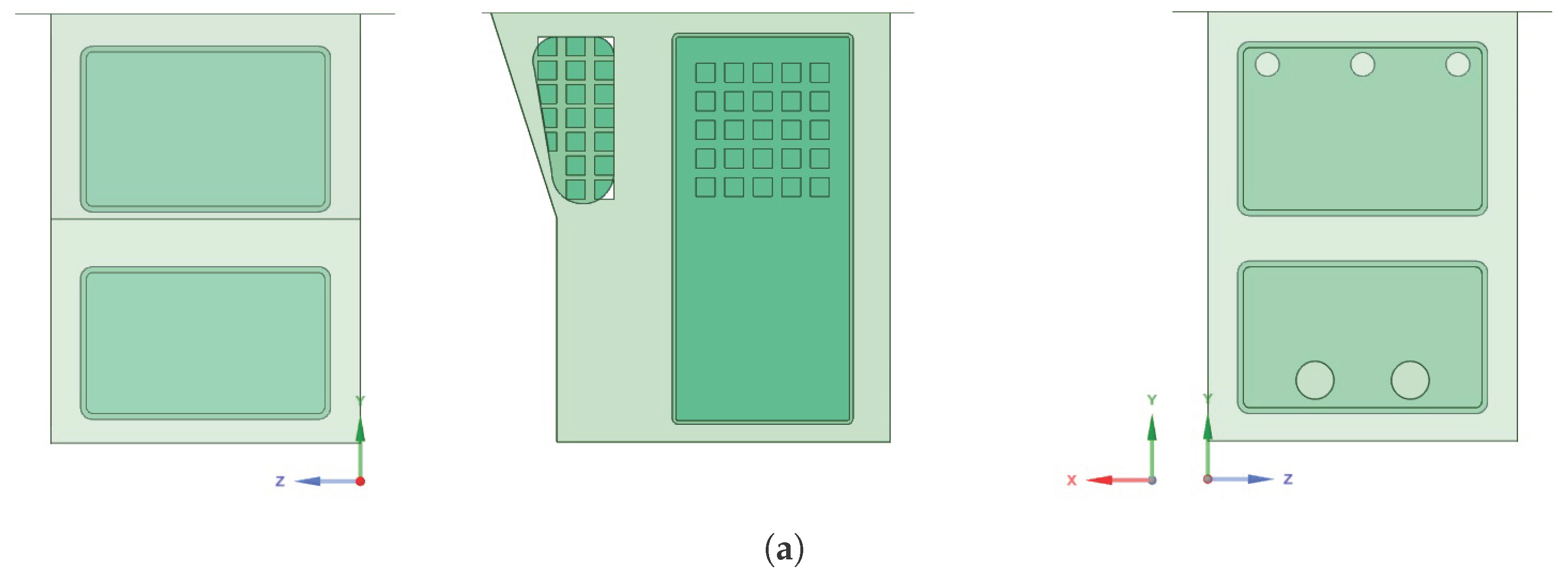

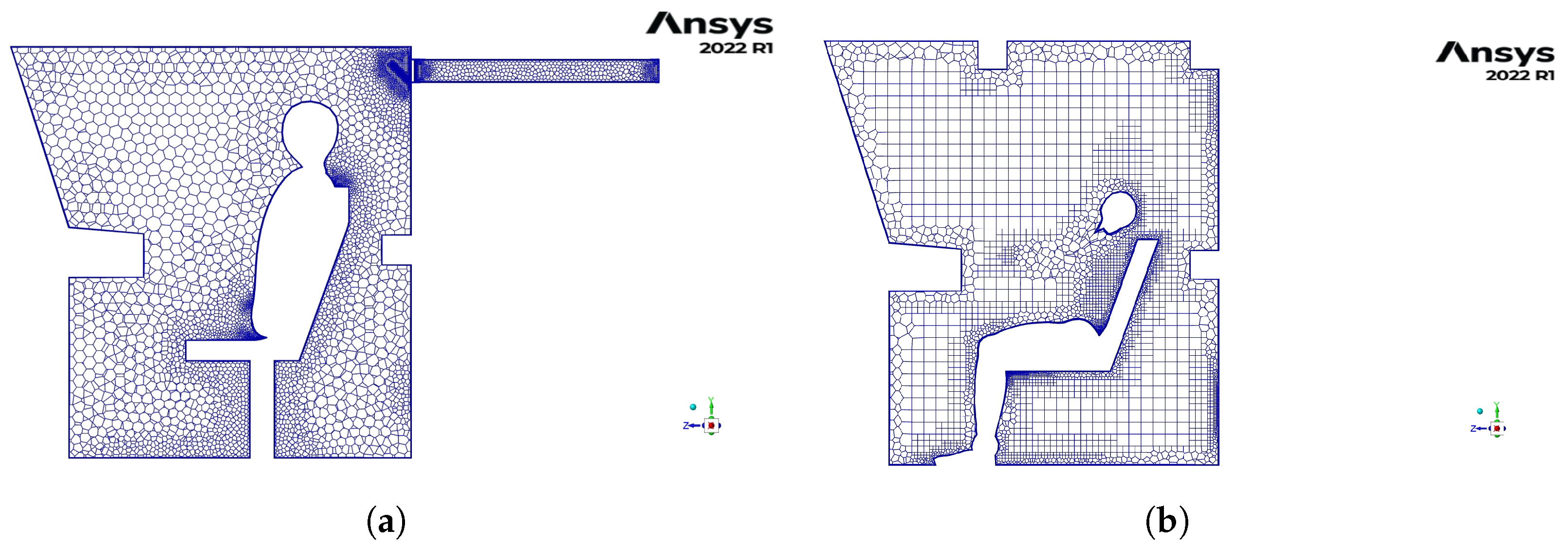



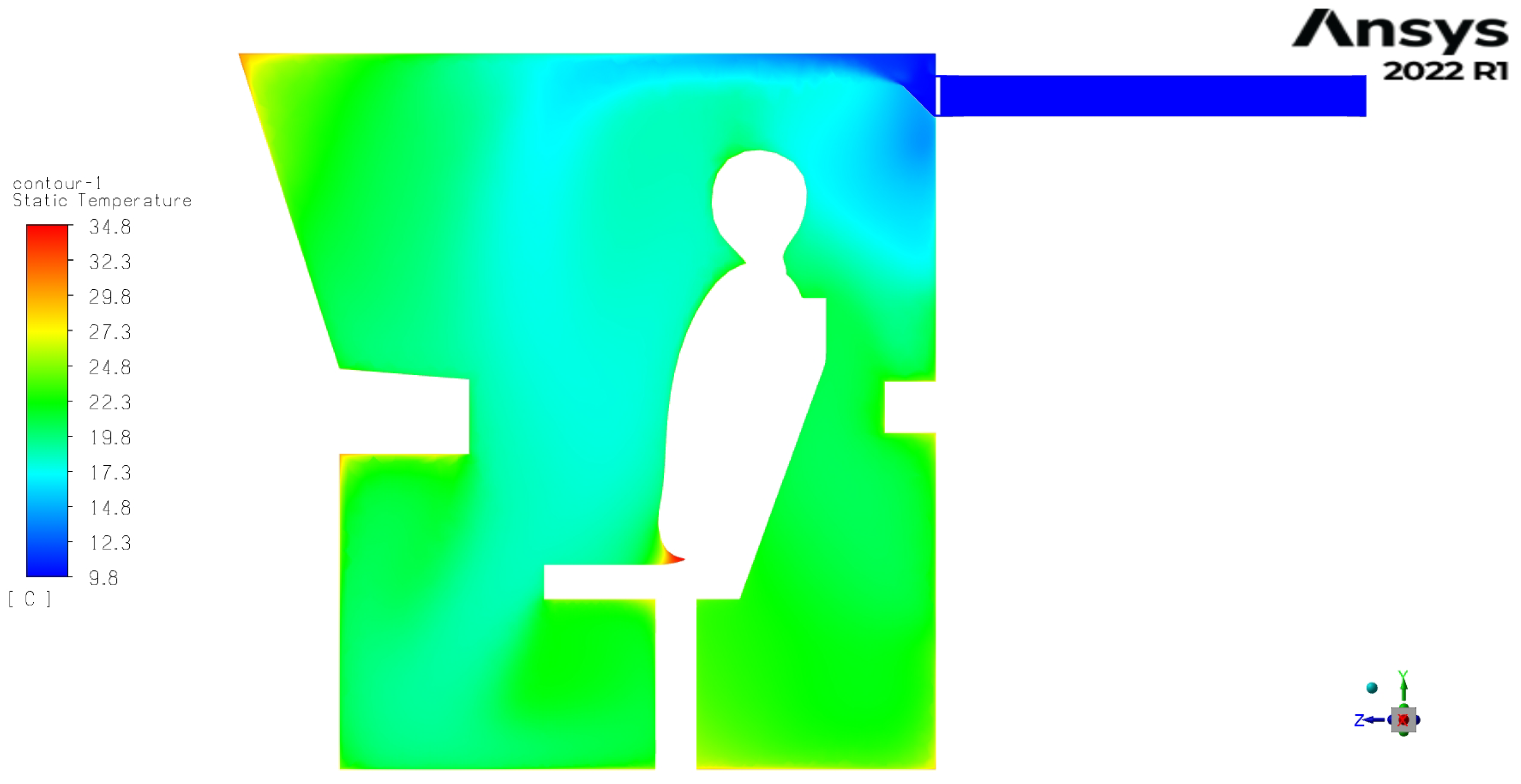
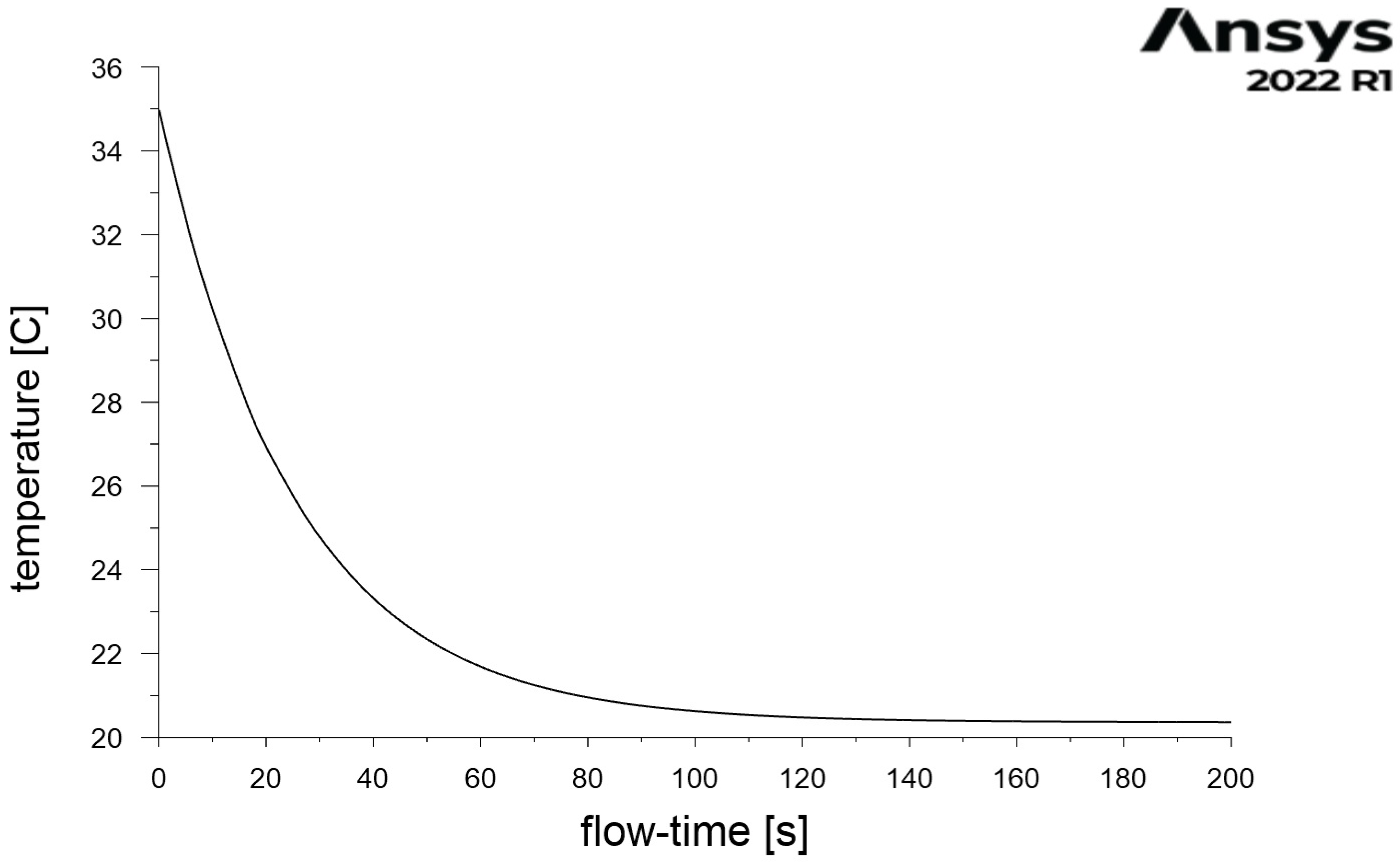
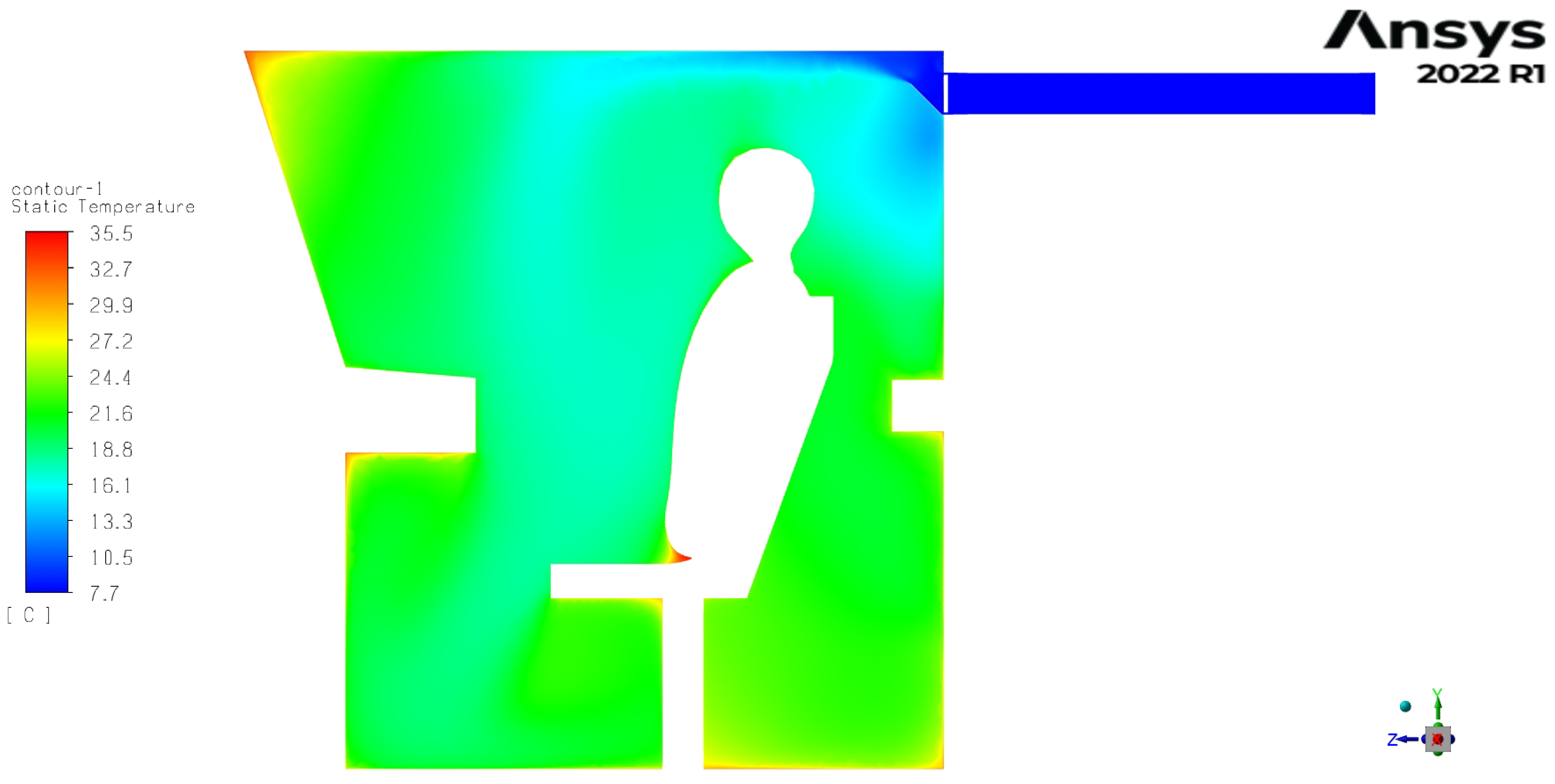


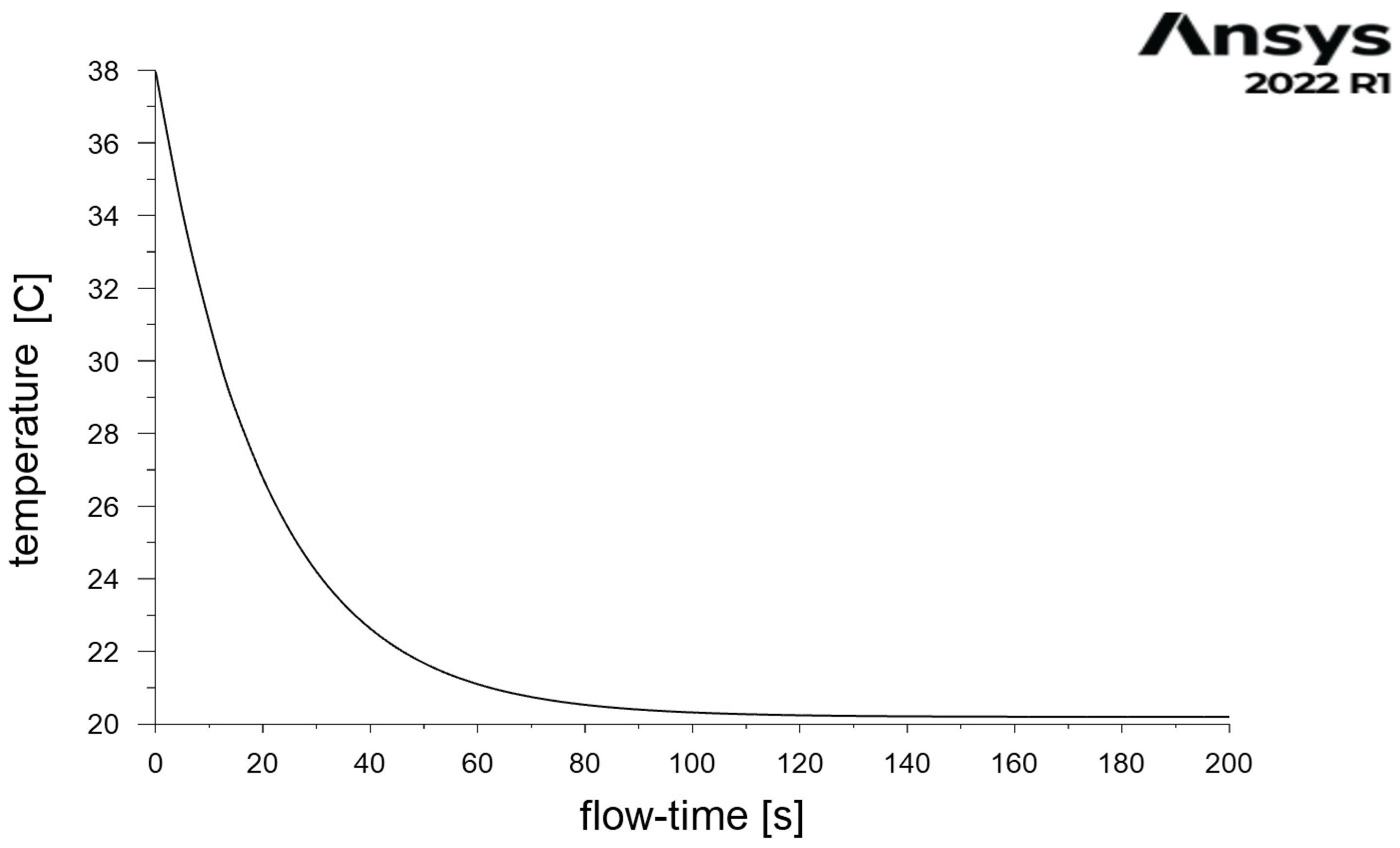
| Description | Dimensions (mm) |
|---|---|
| Total Sitting Height | 884 |
| Shoulder Pivot Height | 513 |
| H-Point Height—ref. | 88.5 |
| H-Point from seat Back—ref. | 137 |
| Shoulder Pivot from Backline | 89 |
| Thigh Clearance | 147 |
| Elbow to Wrist Pivot | 297 |
| Shoulder to Elbow | 338 |
| Elbow Rest Height | 201 |
| Buttock to Knee | 592 |
| Popliteal Height | 442 |
| Knee Pivot to Floor | 493 |
| Buttock Popliteal Length | 465 |
| Chest Depth | 221 |
| Foot Length | 259 |
| Foot Width | 99 |
| Shoulder Width | 429 |
| Chest Circumference | 965.5 |
| Waist Circumference | 851 |
| Name | Boundary Condition |
|---|---|
| Inlets | Velocity—3 m/s; Temperature—10 C |
| Outlets | Pressure—0 Pa |
| Human | Temperature—36.6 C, Radiation (internal emissivity—1) |
| Cabin | Temperature—35.0 C, Radiation (internal emissivity—1) |
Disclaimer/Publisher’s Note: The statements, opinions and data contained in all publications are solely those of the individual author(s) and contributor(s) and not of MDPI and/or the editor(s). MDPI and/or the editor(s) disclaim responsibility for any injury to people or property resulting from any ideas, methods, instructions or products referred to in the content. |
© 2023 by the authors. Licensee MDPI, Basel, Switzerland. This article is an open access article distributed under the terms and conditions of the Creative Commons Attribution (CC BY) license (https://creativecommons.org/licenses/by/4.0/).
Share and Cite
Wróblewski, A.; Macek, A.; Banasiewicz, A.; Gola, S.; Zawiślak, M.; Janicka, A. CFD Analysis of the Forced Airflow and Temperature Distribution in the Air-Conditioned Operator’s Cabin of the Stationary Rock Breaker in Underground Mine under Increasing Heat Flux. Energies 2023, 16, 3814. https://doi.org/10.3390/en16093814
Wróblewski A, Macek A, Banasiewicz A, Gola S, Zawiślak M, Janicka A. CFD Analysis of the Forced Airflow and Temperature Distribution in the Air-Conditioned Operator’s Cabin of the Stationary Rock Breaker in Underground Mine under Increasing Heat Flux. Energies. 2023; 16(9):3814. https://doi.org/10.3390/en16093814
Chicago/Turabian StyleWróblewski, Adam, Arkadiusz Macek, Aleksandra Banasiewicz, Sebastian Gola, Maciej Zawiślak, and Anna Janicka. 2023. "CFD Analysis of the Forced Airflow and Temperature Distribution in the Air-Conditioned Operator’s Cabin of the Stationary Rock Breaker in Underground Mine under Increasing Heat Flux" Energies 16, no. 9: 3814. https://doi.org/10.3390/en16093814
APA StyleWróblewski, A., Macek, A., Banasiewicz, A., Gola, S., Zawiślak, M., & Janicka, A. (2023). CFD Analysis of the Forced Airflow and Temperature Distribution in the Air-Conditioned Operator’s Cabin of the Stationary Rock Breaker in Underground Mine under Increasing Heat Flux. Energies, 16(9), 3814. https://doi.org/10.3390/en16093814








